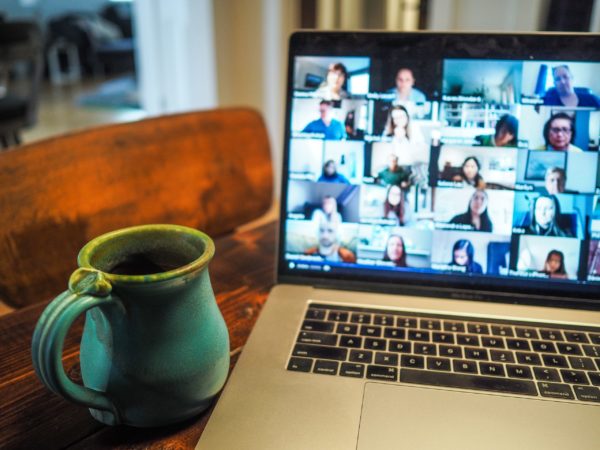
| Date | Author |
|---|---|
| 23rd June 2021 | Claire Taylor MBE |
The hybrid ways of working set up in response to the pandemic may in fact serve us well long after Covid-19 has faded from the rear-view mirror. Following on from a series of posts on post-pandemic working, SUMS Managing Consultant Claire Taylor MBE considers what a hybrid model might mean for the technology we use including opportunities and challenges, software, hardware, and the impact on teaching. Posts exploring the impact of hybrid on the spaces we use and the culture we create are coming soon!
Last month, my colleague Joel Arber wrote a blog about post-pandemic ways of working. He outlined some high-level thinking about what work in universities might look like – and feel like – in the future. Work would be something you do, rather than somewhere you go. Approaches would be hybrid, depending on the requirements of the activity and the preferences of the individuals.
Reflecting on this from a personal perspective, as consultants, we have long worked in a distributed fashion. From working on campus with client institutions, catching up on emails on the train, to switching between working from home and the office, this blog considers what a hybrid model might mean for the technology we use.
Hybrid Working: Opportunities and Challenges
I’m not a Director of IT, but I do have a background in IT (in systems management) and an overriding belief that the demands of the business, the process, the policies and so forth, should drive the demand of the technology. As such I have always put the ‘I’ before the ‘T’. I like to look at the information and data that people need to do their jobs. However, this pandemic has highlighted the differences between the haves and the have-nots in areas including hardware and software.
The current demands on technology can be thought about in any number of ways. I am going to focus on the following: hardware, software, specificity dimension and lastly the need to connect the physical and digital environments.
Hardware
On the hardware side, institutions have done much to provide staff with devices and ancillaries (screens, mouse, keyboards etc.) to work from home. First, organisational pools of laptops were distributed and then staff took home desktops. Directors of IT next started to look at the organisational device policy with a view to updating it for hybrid working.
A key decision to make is where to sit on the organisation vs personal device landscape. This can be different for staff and students. On the one hand, purchasing appropriate devices to enable hybrid working for all staff and students will be very expensive. Hybrid working requires significant recurrent investment as devices require support and eventual replacement. However, this financial and resource investment mitigates several risks, the most important of which is security. Personal devices are notoriously insecure; virus software is not installed or up to date, access is not protected (no password or finger-print access) or poorly implemented, and devices are used by multiple people.
Another key risk is one of up-time. Institutions are more likely to invest in robust devices and an accompanying high-level service package (in HE this is generally in-house with supplier backup). Individual team members are less likely to be able to invest in top-of-the-range equipment and not everyone will have a substitute device if their personal laptop breaks and needs repairing.
The Mixed Model
Most institutions will continue to implement a mixed model, where staff will be issued with work devices – now almost exclusively portable – and students will be supported with a ‘bring your own device’ policy; institutions will provide restricted access through the cloud, to the systems they need. This, accompanied by two-factor authentication, will be an acceptable compromise to the security risks highlighted above.
Be careful of those who fall in the grey areas: for example, research students and precarious staff. Are they treated as full members of staff and kitted out with work laptops or treated as students with restricted access?
One member of SUMS is moving to the Microsoft Surface family for the majority of its staff, with various levels of device to suit users’ needs. Use of other devices will be considered on an individual basis, with IT accepting that it will have to continue to allow some staff to use Mac or specific higher performance devices where a use-case can be made.
Hardware also includes audio: most institutions had moved or were considering a move to VOIP. Universities can now move away from telephone networks altogether; audio following people as they connect at home, in the office, or anywhere on campus.
Software
For software, institutions must ensure that staff have the systems that they require to do their jobs. Pre-pandemic, most institutions had already moved various applications to the cloud. The pandemic will have shown a stark contrast between the systems which are accessible from anywhere and those which required a VPN connection for remote users or mandated a trip onto campus.
In workshops that we have run for members, academics talked of their frustrations in accessing research databases. All staff also spoke of the rationing of VPN connections in spring last year. The principle of ‘anywhere, anytime; is important and should be designed into any new system implementation. Old systems should be upgraded to meet the principle or replaced.
Specificity Dimensions
The generalist vs specialist debate is important here. While there will be a majority for whom an entry-level device is sufficient with a full suite of general use software, there will be others for whom a more sophisticated device is suitable – requiring software specificity. This could include complex research activity and high-performance video or audio editing requirements in the Creative Arts, or manipulating large data sets.
The Impact on Teaching
A lot of thought at many universities has gone into whether the changes in pedagogy driven by the pandemic will endure. While some events have been delivered online, others have remained face-to-face through restricted numbers and frequency.
Universities have shown that first-order change can be supported and teaching events can be replicated online. However, most would agree that the experience has varied greatly, both from the academic and student perspective.
Can lecturers deliver a high-quality experience in each type of teaching in a hybrid approach? Evidence has emerged to suggest that it can be done, but is highly dependent on three things:
- High-quality video and audio technology within the teaching space
- A digital-first approach to accompanying activities (e.g in-stream online multi-choice quiz, additional notes on a digital whiteboard rather than physical)
- Additional in-room support for the lecturer in large or interactive events (teaching assistant).
Principle-based Approach
To explore potential second-order change, SUMS recommends a principle-based approach, focusing on the purpose of the activity.
Large in-person lectures provided a solution to constraints on book supplies and few experts, where access to information was only available in person. We are preparing students for a future with access to quantities of information undreamt of even 20 years ago. Teaching and assessment is now about the meta skills of evaluation and synthesis, of collaboration and insight. Rather than the sharing of information itself, teaching becomes the facilitation of learning.
This will support not only transformation in teaching practices but also transformation in the collaborate nature of workplaces.
Can those platforms support the facilitation of organisation learning? Yes – bringing together service managers, deliverers and users will help transform the effectiveness and efficiency of activities. Technology needs to support this change in paradigm with solutions to connectedness, to community building and socialisation of knowledge.
A Physical and Digital Environment
Physical spaces need to enable technology but not be taken over by it. Teaching spaces require generic and specific technology. These spaces need to provide high-quality experiences for those not in the room, while not reducing the in-person experience. Other specialist spaces will require technology specific to the activities which happen within them. Campuses and areas from which people work need to be highly connected with high levels of saturation and resilience.
Universities have done much to make a quick transition to online teaching, learning and working. What matters now is a commitment to ensure institutions use the right solution for the specific challenge being faced.
Claire’s next blog will explore the hybrid approach in more depth, exploring the impact that it has on the spaces we inhabit and how space management needs to change on UK university campuses in the coming future. As Managing Consultant at SUMS, Claire Taylor MBE helps universities identify effective and efficient solutions to complex organisational issues. Her specialist areas of knowledge include timetabling and curriculum development, space management, IT strategy, integrated planning, payment acceptance and the development of sport strategies and operational plans.








